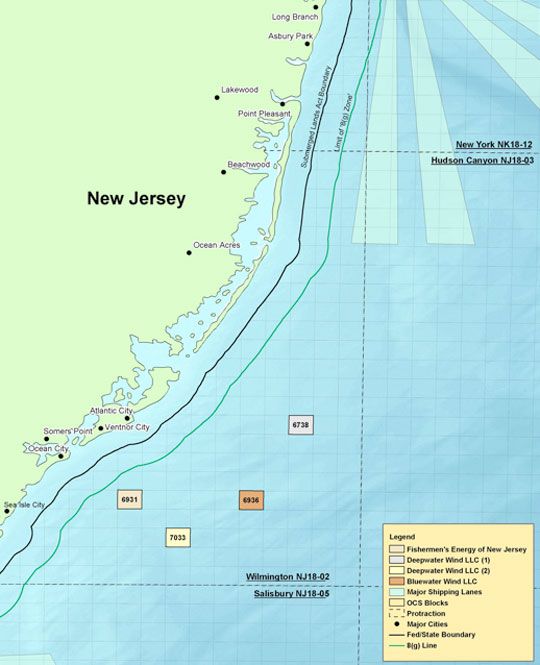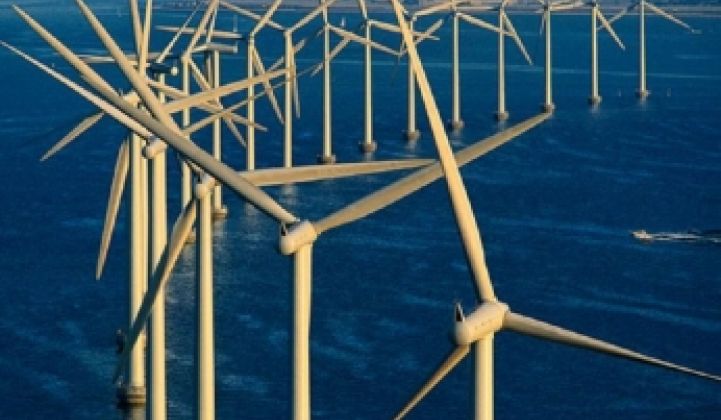[pagebreak:FedsIssueFirstEverOffshoreWindLeases]
In a move to spur renewable energy developments in the outer continental shelf, the federal government has issued five exploratory leases to five offshore wind energy companies.
The 5-year leases are the first-ever that have been issued for investigating the feasibility of building offshore wind farms in federal waters, said Frank Quimby, a spokesman for the U.S. Department of the Interior, which announced the leases Tuesday.
The five companies are set to erect meteorological towers off the shore of New Jersey and Delaware to gather data on wind speed, directions, temperatures and other factors that will determine the optimal sites for wind farms, Quimby said.
The announcement arrived two months after the interior department settled a dispute with the Federal Energy Regulatory Commission (FERC) over who has authority over issuing leases and licenses for projects that generate electricity using wind and ocean currents in the outer continental shelf.
The Energy Policy Act of 2005 authorized the department's Mineral Management Service (MMS) to regulate those energy projects, the Interior Department said.
But the MMS couldn't finalize the rules for administering the offshore energy development program because it wasn't able to reach an agreement with FERC, which asserted that it also had authority to regulate those energy projects.
The interior department and FERC settled their differences in April, and the program is set to start on June 29 this year.
The two groups essentially divvied up the responsibilities. The MMS would have the authority to regulate the production and transmission of energy from non-hydrokinetic projects such as wind and solar. FERC would oversee hydrokinetic projects, such as those that make use of wave and current. Hydrokinetic project developers would still have to apply for leases from the MMS.
There aren't any wind farms located in the outer continental shelf right now, Quimby said. Given that offshore energy development is a young industry, there isn't much information available for determining ideal sites for wind farms, he added.
The five developers that have received the exploratory leases for collecting wind data are Bluewater Wind New Jersey Energy, Fisherman's Energy of New Jersey, Deepwater Wind and Bluewater Wind Delaware. Deepwater is getting two leases to set up the meteorological towers off the New Jersey coast.

[pagebreak:Wind Leases Cont'd]
The meteorological towers would be located from six to 18 miles offshore. The federal government has jurisdiction from three to 200 miles offshore, while states have authority within the three-mile area.
Data from these efforts would have to be made available to the MMS, which will make the information public, Quimby said.
Although the developers wouldn't keep their data to themselves, they have incentives to pay the fees to gather the information.
Bluewater Wind, for example, has signed a deal to supply power to Delmarva Power in Delaware. The agreement would require Bluewater to build a wind farm with up to 200 megawatts in generation capacity.
New Jersey set up a program last October that would give $4 million to each company for erecting meteorological towers.
"The companies have their ducks lined up, and they are confident that they will get the production leases once they have the scientific data they need," Quimby said.
The production leases would allow the companies to build wind farms. Quimby noted that companies that have received exploratory leases for meteorological towers don't get preferential treatment when they apply for production leases.
Collecting meteorological data isn't a requirement for getting the production leases, however.
The developer of the controversial, 420-megawatt Cape Wind project off the coast of Massachusetts already has applied for a production lease, and is going through the permitting process using data it has collected onshore, Quimby said.




